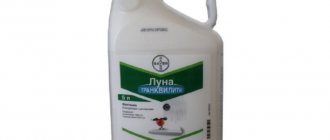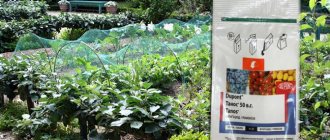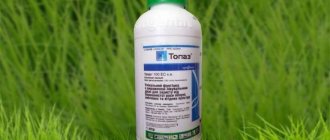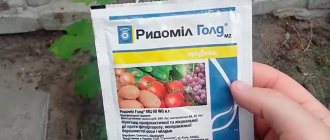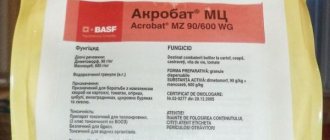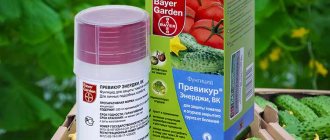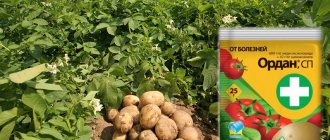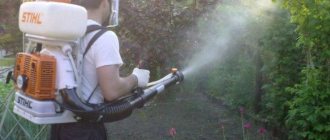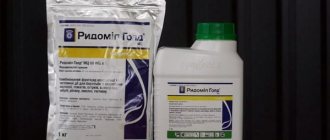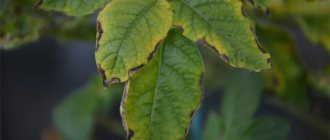Growing fruits and vegetables is unthinkable without proper prevention and protection of crops from dangerous fungal infections. This applies to both indoor plots and farms, since everyone strives for one thing - high yields. Fungicides come to the rescue - special preparations used to destroy pathogens and protect plants from disease and death.
Among the new generation of drugs, Quadris stands out - a product produced by the famous Swiss company Syngenta Crop Protection Co. This fungicide has proven its effectiveness in practice, but it must be used strictly in accordance with the instructions.
Description of the drug and features
In the composition of any fungicide, the base is the active substance, due to which the effect on microorganisms occurs. In the case of Quadris, this is a representative of the strobilurin group - azoxystrobin. The mechanism of action is simple: the component forms a thin film, thereby blocking the supply of oxygen to fungal spores and causing their death.
The effect appears approximately an hour after treatment, the protective period is 14-21 days. After the reaction, the active substance breaks down into safe components that do not pose a danger to people and plants.
Quadris does not contain ions:
- phosphorus;
- sulfur;
- metals
Therefore, after using the drug, its components do not accumulate in plant fruits. Azoxystrobin partially penetrates into the tissues of leaves and shoots, but most of it remains on the surface in the form of a film. Thus, the fungicide refers to preparations of both contact and systemic action.
Available in the form of a highly concentrated suspension (SC), the content of azoxystrobin per liter is 250 ml. Manufacturer Syngenta offers various types of packaging:
- 5 ml and ampoules 5 ml;
- 1 liter bottles.
Strobilurins have been used in agrochemistry relatively recently, so it is necessary to take into account the recommendations of the drug manufacturers, as well as strictly follow the instructions.
Composition, active substance
Active ingredient: 250 g/l Azoxystrobin, chemical class: strobilurins. Azoxystrobin is an analogue of the natural fungal metabolite Strobilurins Oudemansins. Chemically synthesized, in its pure form it is colorless, odorless crystals.
Preparative form: SC (suspension concentrate).
Manufacturer - Syngenta (Syngenta AG) - a Swiss company, a world leader in the production of plant and seed protection products. The registrant in Russia is Syngenta LLC.
Officially available in a 1 ml bottle and a 5 ml canister, but in some cases it is also sold in smaller sizes (6 ml, 10 ml, 30 ml, etc.).
Quadris SK, fungicide - range of products produced
Indications for use
The fungicide is used for the treatment and prevention of diseases caused by fungi:
- late blight;
- cladosporiosis;
- Alternaria blight;
- macrosporiosis;
- powdery mildew and others.
Quadris can treat all fungal diseases. Good results are achieved by those gardeners who use the drug at the first appearance of symptoms.
Mildew
Mildew is downy mildew. Characteristic symptoms of this disease are the appearance of a white coating on the leaves and fruits, a decrease in yield, falling inflorescences, and yellow spots on the front side of the leaf.
Powdery mildew is considered one of the most common and dangerous diseases of grapevines. The grapes do not have time to develop; they gradually acquire a purple tint, and then dry out and fall off. Powdery mildew is caused by high humidity and watering with cold water.
Late blight
Another common grape disease is late blight. The danger of this disease is that it can be transmitted from plant to plant, and if timely measures are not taken, most crops in the region will soon become diseased. Late blight usually appears in the second half of summer. It is caused by excess humidity and low temperatures.
The first signs of the disease are dark spots with a white border that appear on the leaves. The infected parts of the grapes die after some time. The grapes become small, lose their taste and are not suitable for consumption.
Oidium
Oidium is true powdery mildew. As the disease progresses, the fungus also attacks the berries. The grapes, not having time to ripen, begin to crack. The leaves are covered with white spots. Another symptom is the smell of rotten fish.
The main danger of oidium is that the disease develops quickly and can destroy the entire vineyard in just a few weeks.
Gray rot
Inflorescences with gray rot wither and fall off. If the weather is humid, they turn gray. The grapes turn brown and become slimy. Then they rot and fall off. Leaves are rarely affected by the fungus, only when it is humid outside. Then dark spots appear on them. Gray rot develops mainly in September. The occurrence of the disease can be prevented by regular pruning and preventive treatment of shrubs.
Downy mildew
Downy mildew is one of the names for powdery mildew.
Alternaria blight
Alternaria causes necrosis of the above-ground parts of the grapevine (leaves, shoots, petioles). This disease primarily affects weakened vines. Alternaria blight is caused by hot and humid weather.
The leaves begin to become covered with light spots. Based on their appearance, they can easily be mistaken for symptoms of powdery mildew. As the disease progresses, they become dark brown. At the last stage, the leaves turn black and wrinkle. Treatment should begin immediately after the first symptoms appear.
If you delay, the fungus will not only destroy the vineyard, but will also spread to nearby crops.
Powdery mildew
The first signs of the disease appear first on young leaves and shoots. The leaves take on a whitish tint, as if they had been sprinkled with flour or dust. If you rub the leaf with your finger, the coating will be erased.
Black spot
Black spot is also called escoriosis, dry rust and fomospis. The disease affects all parts of the grapes, from stems to leaves. Initially, black spots appear on the leaves, which gradually increase. They are light in color and slightly thickened at the edges. The spots are usually located near the veins. As a result, the leaves become curled. As a result, the leaf turns yellow and falls off.
Spots appear on shoots at the end of flowering. The disease breaks easily. If the disease is ignored, the vine gradually becomes covered with black scabs. When the fungus penetrates deep into the wood, most of the vine dies and can only be dug up.
Infectious drying out
Infectious drying out of shrubs can be caused by a fungal disease - black cancer. Or because of eutyposis. Symptoms of infectious shrub wilt may vary depending on climate conditions and the pathogen.
The disease is divided into two stages. The first stage involves the accumulation of microorganisms in the wood and lasts for 2-3 years. At this time, the disease may not manifest itself in any way. The second stage is drying the bushes. If you cut the stem, there will be dead wood inside. Damaged parts of the vine must be destroyed. To prevent the development of an infectious disease, preventive treatments are carried out in the spring and during the growing season.
Consumption rate
| Agricultural crops | Fungal disease | Required spray rate (l/ha/area) | Number of days from processing to harvest | Maximum number of procedures | Application preparation period |
| Grape | Oidium, powdery mildew | 0,8 | 25 | 3 | Growing period |
| Tomatoes | Late blight, brown spot | 0,6 | 5 | 3 | Growing period |
| cucumbers | Powdery mildew, anthracnose, downy mildew | 0,6 | 5 | 3 | Growth period |
| Potato | Phytophthora, Alternaria | 0,6 | 7 | 2 | Growing period |
| Onion | Downy mildew | 0,6 | 14 | 2 | Growing season |
| Peas | Powdery mildew, ascochyta blight | 0,8 | 7 | 2 | Growing season |
| Cabbage | Rot | 0,6 | 7 | 1 | 10 days before harvest |
| Hop | Powdery mildew | 0,8 — 1,2 | 14 | 3 | Growing season |
Dosage per 10 liters
To treat vegetable crops, prepare a 0.1% fungicide solution. To do this, dilute 1 g of the drug in 1 liter of clean water. For 10 liters the proportions will be as follows: 10 g per 10 liters of water.
To treat hops, tomatoes and cucumbers from various types of fungal infections, 2 treatments will be required. For potatoes, onions and vegetable peas - 3, and for cabbage it is enough to spray the above-ground parts of the plants 1 time. A week after the last application of the Quadris fungicidal solution, you can begin harvesting.
To treat vineyards against gray rot, infectious wilt, powdery mildew, oidium and black spot, it is necessary to dissolve 2 g of Quadris in 1 liter of water. The number of treatments is 3, and the last one must be carried out no later than 25 days before harvest.
Benefits of using Quadris
The main advantage of using Quadris is the fact that it has a fundamentally new mechanism of action on the most common diseases of cucumbers, tomatoes and grapes. In addition, its high efficiency and safety for plants are recognized even at the international level.
Other positive qualities of this drug include:
- long process of influence on plants;
- the ability to prevent the germination of pathogen spores;
- the ability to increase plant productivity, as well as improve leaf photosynthesis;
- improving the quality of the resulting products;
- increasing the profitability of growing garden crops.
Instructions for use
When to treat plantings? The best time is morning or late afternoon, and it is advisable to choose a day without rain or wind. Remove all animals from the affected area and keep people away without personal protective equipment. It is advisable that a distance of more than 150 meters be maintained to the nearest houses and bodies of water.
The maximum working time with Quadris is six hours.
Follow the dosage, excluding dilution of the working solution by eye. Acceptable values for the standard are plus or minus 2 ml. Any overdose leads to plant poisoning, and underdosage reduces the effectiveness of spraying.
For grapes
The drug reliably protects grapes from the most dangerous infections of this crop: powdery mildew and oidium. During the summer it is sprayed twice: before flowering prophylactically and after 2-3 weeks.
Solution proportions: 60 ml of Quadris per 10 liters of water. When planting in a vineyard, use a liter per 1 square meter. m.
When coloring grapes, do not use fungicides.
For tomatoes (including in the greenhouse) and peppers
Tomatoes and peppers are susceptible to late blight, Alternaria and powdery mildew. For open ground, dilute 40 ml of fungicide per 10 liters of water. Consumption per 10 square meters is 6 liters.
According to the instructions for use of Quadris, to treat greenhouse crops, take 80 ml of suspension per 10-liter bucket of water. The solution consumption per 10 square meters should not exceed 1 liter.
Plants are treated no more than 2 times per season:
- Before flowering begins.
- When the first fruits appear.
When growing tomatoes and peppers in the ground, the intervals between treatments should be 2 weeks. Greenhouse plants are treated no more than once every 10 days.
For cucumbers (including in the greenhouse)
Quadris solution is used to prevent and protect plants from anthracnose, powdery mildew, powdery mildew, and downy mildew of cucumber in open or protected ground. Shrubs are treated with this drug no more than 3 times per season.
| Processing period | Diseases | Preparation of the solution | Consumption rates per 100 m², l |
| when 2-4 true leaves appear | for the prevention of powdery and downy mildew | 6 ml of the drug is dissolved in 5 liters of water | 5 |
| at the beginning of fruiting | powdery and downy mildew, anthracnose, downy mildew |
The use of Quadris prolongs the growing season of cucumbers.
For strawberries
Treating strawberries with a solution of the fungicide Quadris provides protection against gray mold, spotting and other fungal infections.
Forty ml of the drug is added to a 10-liter bucket of water. Treatment is carried out before flowering, repeated spraying after harvesting.
For potatoes
Treatment with Quadris protects potatoes from rhizoctonia and scabies. According to the instructions for using the fungicide Quadris, add 0.3 liters of suspension to a 10-liter bucket of water.
The volume of the solution depends on the area where the potatoes are planted. For every 10 m2, 0.8 liters of ready-made solution is required. If the treatment was already carried out last year, you can increase the indicated rate to 2 liters.
Before planting tubers, the soil is irrigated. The protective effect of the drug lasts for 2 months.
For pears, fruit trees and shrubs
Fruit trees are often susceptible to fungal diseases, so their condition should be monitored very carefully. Fungicide treatment is carried out immediately before the flowering period. Spraying is repeated after harvesting. This will help prepare the plants for the next season and develop resistance to fungal diseases.
For garlic and onions
Spray only those onion beds that are grown under turnips. Quadris cannot be used to treat plants growing on feathers. Therefore, Quadris is also suitable for garlic treatment.
During the summer season, onion and garlic seeds can be processed up to 5 times, with an interval of 10-14 days between sprayings. The working solution is prepared as follows: 20 ml of the drug per 2 liters of water. Use 20 ml of working solution per 1 m2 of area in the first year and 40 ml in the second year of cultivation. Treat the beds with onions for the first time when the shoots appear.
For the lawn
Quadris fungicide was originally developed for use on sports turfs. The use of the drug eliminates fusarium and various stains. As a result, the grass's resistance to trampling increases.
For processing, a working solution is prepared containing 120 ml of the substance per 10 liters of water. If the drug is used in the first year, it is enough to use 0.2 liters of solution per 10 m2 of lawn. In the second year, twice as much solution is used.
The first treatment is carried out when the sprouts begin to produce their first leaves. The procedure is repeated every 20 days. No more than 4 procedures are allowed per season.
Safety precautions
The active ingredients of the fungicide "Quadris" belong to hazard class II for humans and class III for bees. If basic safety rules are followed, the drug can be called safe for the environment and humans:
- Do not spray grapes during flowering.
- Do not allow aerosol droplets to fall on the ground. The fungicide is insoluble and does not decompose in water; if it gets into groundwater, it can harm animals in nearby bodies of water.
- Do not use Quadris near bodies of water (within a radius of 2 km).
- Processing of plants must be carried out in a special protective suit and gas mask.
- For some types of plants, in particular apple trees, even residual microdoses of Quadris can lead to the death of the crop and the entire plant. Therefore, do not use the sprayer after Quadris to spray garden crops.
- Do not allow the working solution to come into contact with other plants during spraying. This is especially dangerous in windy weather.
- The liquid must be prepared in a special room inaccessible to strangers.
- Work with plants can be continued after 3 days.
Precautionary measures
Despite the low toxicity of the product, it is necessary to work with Quadris with the following precautions:
- Protective clothing. When spraying, it is recommended to wear safety glasses, a mask, gloves and a hat.
- Weather conditions suitable for work. Do not treat vegetation during strong winds, before rain or in hot weather.
- Protect other crops from the effects of Quadris. According to the instructions for use of the drug, almost all plants on the site respond painlessly to treatment with the drug. The exception is some varieties of apple trees, the leaves of which can burn under the influence of a fungicide.
Using Quadris in accordance with the instructions is safe not only for people, but also for bees, birds, beetles and insects. However, the drug has a toxic effect on the inhabitants of water bodies. Therefore, it is forbidden to use the fungicide near rivers and reservoirs, as well as pour the remaining solution into them.
Do not store open containers in food or water storage areas or in areas where children and animals have access.
The best preventive remedies for late blight
Revus
The first place is occupied by a triple-action fungicide, which was recognized as the best in the fight against late blight and today has no analogues. Penetrating through the foliage, it spreads throughout the entire internal system of the crop, preventing the occurrence of infection. The product is resistant to washing off by rain and retains its properties during temperature changes. Since the solution is quickly absorbed, you can water it within 1 hour after spraying. It can be combined with any agricultural fertilizers and chemicals.
After treatment, productivity increases, the quality of fruits and the shelf life of vegetable products improves. The remedy for late blight belongs to a low toxicity class. It does not affect microflora, humans, domestic animals, earthworms, or bees.
Low consumption makes the product economically profitable. Reviews confirm the pronounced and prolonged action. The innovative drug has become a real salvation for agricultural plantations of potatoes, onions and tomatoes, even during periods of heavy and prolonged rainfall.
Advantages
Flaws
Acrobat MC
The drug included in the rating has proven its effectiveness both in scientific tests and during practical use. "Acrobat MC" is in second place. It has proven itself excellent in the prevention of many diseases, including late blight, Alternaria, mildew, and peronospora. The remedy for late blight is actively used on private and farm potato plantations, vineyards, fields with tomatoes and cucumbers. It does not affect the bacteriological composition of the soil and is non-toxic for earthworms, animals, birds, and insects.
The drug is allowed to be used in sanitary fish farming zones near water bodies. It is applied during all plant growth. The effect occurs instantly and lasts up to 3 weeks. The fungicide not only eliminates external plaque, but also prevents the fungus from penetrating into the internal systems of the crop. It is used with all chemicals.
Further agricultural work can be carried out on the 3rd day after spraying the solution. According to reviews, the greatest effectiveness is achieved when using the product at the beginning of the season.
Advantages
Flaws
Trichodermin
The bronze medalist of the rating is a plant-safe fungicide that belongs to the latest generation of preventive drugs against late blight. It protects against 60 types of fungi, stimulates growth, increases crop immunity and soil fertility. The drug is used to treat potatoes, tomatoes, tobacco, cucumbers, peppers, zucchini, cabbage, and radishes. It is also widely used for infection of grapes, coniferous trees, fruit and berry bushes, and ornamental flowers.
The remedy for late blight is produced in liquid and powder form. It is non-toxic to humans, animals, beneficial insects, and does not disturb the biobalance. The substance does not accumulate in fruits and is not addictive to pathogens. It is used in combination with all chemical and biological preparations and on all types of soils.
The most important advantage is a lasting effect that lasts up to 1 month. "Trichodermin" is highly resistant to moisture and protects the plant from the inside and outside. It is used both on open soils and in greenhouse conditions.
Advantages
Flaws
Ordan
On the fourth line of the rating is a drug that is effective against all stages of late blight and peronosporosis. It is used to infect potatoes, tomatoes and cucumbers grown in greenhouses and open ground, garden flowers and shrubs. The remedy for late blight is not addictive in pathogens and is classified as a moderate type of toxicity. It not only protects against infection, but also improves the condition of the plant after negative natural influences.
"Ordan" has both a preventive and therapeutic effect. The manufacturer has proposed innovative packaging that does not require opening. It dissolves in water along with the contents, but does not clog the spray nozzles.
The opinions of experts and summer residents coincide. To increase productivity and eliminate diseases caused by pathogenic fungi, this is one of the best remedies at an affordable price. Water-soluble bags make preparation easier before spraying, reducing the time required for the entire process. The drug is harmless to the environment and humans.
Advantages
Flaws
Fitosporin
Fifth in the ranking is a biologically active drug of natural origin. It ideally combines high preventive properties against late blight and absolute safety for people, animals, surrounding plants, which does not require treatment. The remedy for late blight is available in several forms: as a suspension, powder and paste. It is actively used not only in gardens, but also at home to protect indoor flowers from pathogenic infections.
The solution, falling on the leaves, penetrates inside and spreads throughout all systems, including the root system. It prevents the appearance of black rot, bacteriosis, powdery mildew, Alternaria, scab, rust, cercospora, fomoz and a whole range of other diseases. The biological product retains its properties when frozen and defrosted. At low temperatures, bacteria go into a dormant state, but under favorable conditions they become active again.
The advantage of the product was its use at all stages of cultural development. It helps eliminate stressful conditions after waterlogging, burns, freezing, and enhances growth.
Advantages
Flaws
Quadris
Rounding out the ranking of the best preventative drugs is a fungicide that has proven itself to be excellent in preventing infection of potatoes, tomatoes, cucumbers in indoor and outdoor soil, grapes, and onions by spores of pathogenic fungi. It is also used to maintain the healthy appearance of sports and decorative lawns. High stimulating properties enhance the effect of photosynthesis and increase productivity several times.
The drug belongs to a low hazard class and is harmless to other plants, humans, animals, fish, birds, and bees. It is compatible with almost all types of insecticides and is resistant to heavy rainfall. The manufacturer recommends not to apply treatment 120 minutes before forecast rain. The required time to stabilize the solution and fix it on the foliage is 2.5 hours.
The surveyed summer residents noted that the product protects not only from late blight, but also from many other primary and secondary diseases. It is economically consumed, does not form an unpleasant odor, and does not cause allergic reactions.
Advantages
Flaws
Processing times
The drug is suitable for prophylactic use and in the early stages of the disease. It suppresses the development of the fungus and the formation of spores, but does not lead to its complete destruction. The period of action of Quadris on grapes is about three weeks. The waiting time for the drug to take effect is 2-3 days.
The right time to treat grapevines is:
- before flowering;
- after flowering;
- time of immature ovaries;
- a week before harvest.
Treating the vines immediately before harvest extends the shelf life of the grapes. Repeat treatment no earlier than after 3 weeks. Do not carry out more than two treatments with Quadris in one season, but use it alternately with other fungicides.
How to save tomatoes from late blight: procedure
The danger is that it will no longer be possible to cure diseased plants, so the main hope of gardeners is to prevent infection and take preventive measures. There are two algorithms of action:
If a disease appears in a greenhouse, the first thing to do is disinfect the room with chemicals. If you open the doors on one side of the greenhouse, the humidity normalizes. Plants need to be watered at the roots - rarely, but a lot, and at the same time add nutrients dissolved in water - potassium, phosphorus and microelements - into the soil.
In open ground, the risk of developing late blight is much higher, so potato plantations will also have to be treated here. To save the harvest, if tomatoes are infected with late blight, it is necessary to mow and burn the potato tops closer to the time of harvest, since drying shoots are a suitable environment for the growth of the fungus. This will keep the tomatoes healthy until they ripen.
Treatment of tomatoes with chemicals
For the tomatoes themselves, there are two methods of protection - with the help of chemicals and folk recipes aimed at destroying the nascent colony. The most effective chemicals are those that contain copper:
Contact systemic fungicides are more universal in their principle of action. They simultaneously work inside the plant, penetrating the integumentary epithelium, and outside, protecting the aerial part from the entry of new spores.
One of these effective remedies is the drug Ridomil. The composition includes two different substances that enhance each other’s properties and comprehensively protect tomatoes from late blight and other fungal infections.
Quadris is a systemic fungicide, especially effective at the first signs of the disease. It affects the vital signs of spores, preventing the formation of a colony and the transfer of the pathogen to neighboring bushes. Effectiveness decreases with severe infestation.
Fungicides designed to eliminate late blight on tomatoes have two main advantages - they are not washed off by rain or watering and have a long period of action - 2 weeks.
In addition to targeted drugs in the countryside, you can use:
The latter has a clear advantage, as it is completely safe for humans. Treatments against late blight can be carried out right up to harvest. In normal weather, treat with Fitosporin every 10 days for prevention. If it rains, you need to spray the bushes again. With the help of Fitosporin, you can survive prolonged humidity caused by precipitation and preserve the harvest without the risk of poisoning with copper-containing drugs.
Treatment of tomatoes with folk remedies
If tomatoes are sick with late blight: how to treat with folk remedies so that the products from your garden are not toxic. For this purpose, various combinations of dairy and fermented milk products, vegetable tinctures, and alkalizing solutions of salt or soda are used.
If you dilute half a glass of salt and soda in a bucket of water and spray, this will also reduce the likelihood of complete infection of the plantation with late blight.
Advantages and disadvantages
Quadris is an innovative product that has its advantages:
clear focus against sporulation of pathogens;
effectiveness against dangerous microorganisms and neutrality towards almost all beneficial fungi (this is very important for novice gardeners who cannot always immediately recognize the symptoms of infection);
safety for soil microflora;
limited translaminar effect (accumulation in leaf blades, lack of penetration into shoots, fruits);
Fruit harvesting is allowed within 3-4 days after treatment;
protective properties do not depend on weather conditions (active at temperatures from +4ºC to +30ºC);
compatible with a large number of fungicides (Topaz, Dzherelo, Defender);
it is compatible with all biological products;
in addition to protecting and treating plants, Quadris helps increase resistance and resistance to weather conditions;
It is allowed to treat the seeds before sowing (according to the instructions).
Do not use Quadris with other drugs containing strobilurins, or with herbicides.
The instructions draw attention to the disadvantages of the fungicide:
refers to toxic substances (for humans - hazard class II, for aquatic life - I). To do this, it is necessary to observe safety measures during processing, take into account the location of plots and plantings in relation to ponds, rivers, streams;
causes dependence on pathogens, which reduces effectiveness over time. Quadris can be used for no more than 2-3 years in one area, with mandatory alternation of treatments with other fungicides;
due to the penetration of the active substance into the flowers of plants, it is prohibited to use Quadris during flowering (may cause poisoning of bees);
phytotoxic for most crops, therefore strict adherence to the dosage of the drug, as well as the rules of treatment, is required.
to completely destroy fungi, it is necessary to use Quadris with preparations of a different chemical base;
high price.
For each crop, the manufacturer has developed specific dosages and consumption, so it is necessary to carefully observe the proportions and act strictly according to the instructions during treatment.
Cross interaction
"Quadris" is compatible with other pesticides that are not strobilurins. It can be mixed in one container with the following fertilizers:
- "Aktara";
- "Karate";
- "Zeon";
- "Aktellik".
Fruit trees are treated before they bloom.
It is not recommended to mix the drug with herbicides due to the difference in shelf life. Before mixing, it is necessary to check the components for compatibility.
If one of the components is in a water-soluble package, then it is dissolved first in the sprayer tank.
Best before date
"Quadris" is stored for no more than 3 years in a place protected from light and moisture. The room temperature should not be lower than -5 and not higher than +40. Upon contact with liquid or excess humidity in the room, the fungicide loses its properties and the degree of effectiveness decreases.
Do not store the drug near food or drinking water.
Storage rules
It is recommended to store the fungicide in dark rooms, maintaining the air temperature in the range from minus five to plus thirty-five degrees. Never place boxes of fungicide in the same area where food is stored. When purchasing, be sure to pay attention to the expiration date of the product, as it may only be effective for three years from the date of manufacture.
Signs of late blight infection in tomatoes
Tomatoes are more often affected by late blight than other plants, as they belong to the nightshade family. Late blight is considered the main enemy of this species. It will take a maximum of 2 weeks for the entire crop to become stained. This happens with both green and ripe fruits. Depends on when the disputes began to actively operate.
What are the early signs that it’s time to start fighting the fungus:
It is important to save crops before damage to the above-ground parts begins. To do this, in the second half of summer, when the ovaries begin to fill out and increase in size, it is necessary to inspect the bushes every day and pick off leaves on which a white coating is noticed.
It is also necessary to inspect the potato bed, since late blight can come from there, because the scientific name of potatoes is tuberous nightshade.
If the difference between day and night temperatures ranges from 7 to 11 degrees, these are the most favorable conditions for fungal infection, especially if it rained for several days in a row.
With a lack of boron and magnesium, moisture in the soil, and calcium, tomatoes also darken, so the symptoms can be easily confused.
Other possible reasons:
Such a natural phenomenon as prolonged rains cannot be corrected, so all that remains is to follow the remaining rules and hope that late blight does not have enough strength to destroy the entire crop.
Analogues, what to replace
Like many other fungicides, Quadris has analogues whose effect on pathogens is identical. The list includes:
- Folicur - produced by Bayer, used mainly on cereals and rapeseed oilseeds;
- Strobi - produced by BASF, the active ingredient is kresoxim-methyl (from strobiluride);
- Consento is a systemic fungicide produced by Bayer. Used against late blight and Alternaria on tomatoes, potatoes, against downy mildew on onions;
- Prosaro is a systemic fungicide manufactured by Bayer. Highly effective when used on grain crops, oilseed rape, corn, peas against septoria and fusarium.
If necessary, these drugs can be used instead of Quadris, taking into account the instructions.
Reviews
Alexandra, 38 years old, Pskov
In the summer, I always treat my tomatoes against Alternaria and other fungal diseases. After using various drugs, I settled on Quadris. It is a low toxicity product that works well in low temperatures and rain. I treat the plants twice with an interval of 10 days. The disease destroyed my neighbors' potato bed, but no symptoms appeared on my tomatoes.
Dmitry, 57 years old, Stavropol
I grow grapes, also for sale. Therefore, preventive treatments are an essential part of vineyard care. One of the most effective is the fungicide "Quadris", which is available in the form of a suspension. According to the instructions for use, I dilute Quadris in 5 liters of water. This treatment protects the vines from anthracnose, blight, oidium and various diseases. After spraying, the grapes did not get sick; next year I will definitely repeat the treatment.
Elena, 42 years old, Novosibirsk
I have been using Quadris for several years now. It is effective against late blight, which affects tomatoes. When the first signs of the disease appear, I prepare a solution for spraying the bushes. Quadris has a worse effect on potatoes, so it is better to choose another drug. 10 days before harvesting, I also spray the cabbage with Quadris. This treatment increases the resistance of cabbage heads to rotting, so the crop can be stored until spring without any problems.
Preparation of working solution
Quadris SK has detailed instructions for use, so preparing a working solution will not cause problems even for novice gardeners.
The finished mixture must be applied to plants using a sprayer. It is recommended to dilute the solution in the bottle itself, which should be filled with clean, preferably filtered, water.
The instructions for use indicate that the dosage is different for different types of crops. However, there is a certain rule for preparing the composition:
- The container should be filled ¼-1/3 with water.
- Add the required amount of the drug.
- Mix.
- Add the required water level.
Important!
Before use, the container with the fungicide must be shaken, since the drug tends to settle. The finished product should be used within 24 hours after dilution, which is also indicated in the instructions for use.
